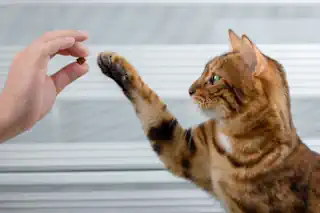Beginners Guide to Training Your Ferret: Furry Mastery in Your Hands

Ferrets are enchanting creatures with a playful and inquisitive nature that make them adorable pets. Their diminutive yet daring dispositions don’t just warrant cuddles; they’re also wired to learn and respond to training. If you are one of those proud ferret owners then let’s get started with this discussion on how to train your ferret before your ferret learns some bad behavior.
Understanding Your Ferret’s First Principles
To begin this epic tale of training, it’s important to recognize that ferrets aren’t just small, fuzzy cats. These unique animals have distinct behaviors and needs, and comprehending their world is the first step toward a successful training endeavor.
Here are the top 5 behaviors every ferret owner should become familiar with to deepen their bond and understanding:
Curiosity Unleashed: Ferrets are naturally curious creatures, always on the lookout for new experiences. Understanding this can help you create stimulating environments and training sessions that keep them engaged and happy.
Playtime Pioneers: Ferrets love to play, and this behavior is crucial for their physical and mental health. Interactive games are a fantastic way to bond with your ferret and keep their minds sharp.
Snooze Mode: Though they’re known for their energetic antics, ferrets also spend a good amount of their day sleeping. Creating a cozy and safe sleeping area is essential for their well-being.
Nipping Know-how: Ferrets might nip during play or when they’re scared. It’s important to recognize this behavior as a form of communication rather than aggression, guiding you to adjust your interactions or their environment accordingly.
Hoarding Habits: Ferrets are natural hoarders, often hiding away toys, socks, and other small items. Understanding this behavior can prevent panic when things go missing and is also key to creating an enriching living space that respects their instincts.
Deciphering Communication Cues
A substantial part of ferret ‘speech’ lies in their body language – from arched backs to the classic ‘weasel war dance.’ Understanding these cues is vital in knowing when your ferret is receptive to training, or when they just need some ‘me’ time.
The Top 5 Ferret Body Language Communication Cues
Ferrets communicate volumes through their body language, and tuning into these signals can greatly enhance your relationship. Here are the top 5 cues to watch for:

The Weasel War Dance: Often mistaken for frantic behavior, this playful hopping and darting around is a ferret’s way of expressing joy and inviting you to play. It’s a heartwarming sight that signifies your ferret is in high spirits.
Slinking Low: When your ferret moves close to the ground, almost slinking, it indicates fear or uncertainty. This could be a response to a new environment, loud noises, or the presence of strangers. Offering comfort and a quiet space can help them feel secure.
Dozing Off Outside Their Den: If you find your ferret snoozing in open areas rather than in their cozy hideout, it’s a sign they feel safe and content in their environment. It’s a testament to the trust and comfort they find in their home with you.
The Stiff Tail: A ferret’s tail can tell you a lot. When they are excited or alert, you might notice their tail puff up or become stiff. This is their way of responding to new stimuli or showing interest in something.
Nipping: Though it might seem alarming at first, gentle nipping is often a ferret’s way of seeking attention or indicating they want to play. However, it’s crucial to distinguish between playful nips and more aggressive biting, which can signal distress or fear.
Recognizing and responding to these cues not only deepens your connection but ensures your furry friend feels understood and cherished.
Tailoring the Learning Plan
Each ferret has its own quirks and personalities, so a one-size-fits-all training approach just won’t cut it. Tailoring your methods to match your ferret’s unique style is like choosing a bespoke suit – it fits perfectly.
Create a Haven for Learning
Now that we grasp the basics, it’s time to curate a learning environment that’s as nurturing as it is safe.
Safe Spaces and Zones
Ferrets are escape artists, so beginning in a secure, confined area will not only feel less daunting but will also ensure they can learn without the distraction of the whole house to contend with.
The Power of Play
Tricks and obedience might sound serious, but with ferrets, playtime is critical. It’s not just fun; it’s the relational currency that’ll galvanize your training efforts.
Utilize Their Social Hour
Ferrets are highly social animals, which makes them prime candidates for training that requires interaction. Use treats, toys, and plenty of endearing chatter to keep them engaged.
The Basics of Obedience Training
The foundation of any good behavior is a solid grasp of obedience. These are the basics that ensure your ferret can follow your lead.

Top 5 Basic Obedience Items to Teach Your Ferret
Training your little adventurer can be both rewarding and fun. Keeping things positive and playful, here are the top five basic obedience cues to start with:
Come When Called: By associating a specific sound or word with treats, you can teach your ferret to come when called. This is crucial for their safety and for moments when playtime ends.
Litter Training: Though ferrets tend to choose one spot for their business instinctively, guiding them to use litter boxes consistently makes for a cleaner, happier living situation.
No Bite: Teaching your ferret that biting is not an acceptable form of play is important. Using firm, consistent commands and rewarding non-biting behavior can curb this habit.
Leash Training: Getting your ferret comfortable with a harness and leash expands the horizons for outdoor adventures together. Start by letting them wear the harness during playtime.
Stay/Stop: Teaching your ferret to halt on command or to stay in one place, even for a short time, can be incredibly useful, especially when you need them to pause their explorations for safety reasons.
Each of these skills lays the groundwork for a well-behaved ferret, enhancing your bond and making every day a joyous adventure together.
Graduate to Advanced Techniques
Ferrets are no strangers to the acrobatic; up next is pushing the envelope with more advanced training.
Top 5 Advanced Things to Teach Your Ferret
Once you and your ferret have mastered the basics, it’s time to step up the game with some advanced tricks and behaviors. Here’s what to aim for next:
Fetch: Despite the common belief that only dogs fetch, ferrets can learn this game too. Start with a favorite toy and lots of encouragement, and your ferret will be bringing items back to you in no time.
Roll Over: Ferrets can be taught to roll over on command, much like dogs. This trick requires patience and treats for positive reinforcement, making it a fun challenge for both of you.
Play Dead: Teaching your ferret to ‘play dead’ on command is not only an impressive party trick but it’s also a great way to engage their natural acting skills. Use a specific hand signal or command, and reward them for staying still.
Jump Through Hoops: With their agile bodies, ferrets can learn to jump through hoops or over barriers. Begin with low heights and gradually increase as they become more confident.
Spin in a Circle: Training your ferret to spin in a circle on command is both adorable and a testament to their learning capability. Use a treat to guide their movement in a circle, then introduce the command word.
Pushing the boundaries of training with these advanced techniques not only stimulates your ferret’s mind but also strengthens the bond you share. Always use positive reinforcement and keep each training session short and sweet to maintain their interest and excitement.
Ferret Finesse on the Field
Agility training is a feast for the senses of both you and your ferret. Set up an agility course and watch as your little noodle navigates with self-assurance.
Consistency is King
The secret to any training lies in consistency. Ferrets are no different; in fact, because they learn through play, being consistent is paramount to avoid confusing your furry trainee.

Top 5 Tips for Ferret Training
In the joyous yet challenging endeavor of ferret training, here are five golden tips to guide you through creating a harmonious and entertaining environment for both you and your furry friend:
Patience is Your Best Friend: Understanding that progress takes time is key. Be patient with your ferret, as they may not grasp new commands or tricks immediately. Celebrate small victories and remain consistent with training sessions.
Positive Reinforcement Works Wonders: Ferrets respond magnificently to positive reinforcement. Use their favorite treats, extra playtime, or cuddles as rewards for good behavior or successfully learning a new trick. Spraying bitter apple scent on areas you want your ferret to stay away from is productive but should never become a negative experience for your ferret.
Keep Training Sessions Short and Engaging: Ferrets have short attention spans. Therefore, keeping training sessions brief (just a few minutes, 5-10 minutes) ensures they stay interested and don’t get overwhelmed or bored.
Introduce New Challenges Gradually: Once your ferret masters a basic command, slowly introduce more complex tasks. Building on their successes keeps them engaged and eager to learn more.
Consistency Across the Board: Ensure everyone in the household is on the same page with commands and training techniques. Consistency helps reinforce learning and prevents confusion, making the training process smoother for your ferret.
Remember, every ferret is unique, and adapting these tips to fit your pet’s personality and learning style will make for a rewarding training experience.
Stick to a Schedule
Like clockwork, a regular training schedule will become the highlight of your ferret’s day. Stick to it and watch as they eagerly scamper to their makeshift classroom.
The Patient Trainer’s Creed
Training any pet can lead to tests of patience, and with ferrets, it’s an ongoing lesson.
Set Small Goals, Achieve Big Feats
Tiny steps can lead to impressive jumps for joy. Be patient, and don’t rush the process. Every milestone reached is a victory for you both.
One Step at a Time
Mastering each trick or command takes time. Be content as you check off your training list one item at a time, and soon you’ll be the envy of other ferret co-guardians.
Conclusion: Your Ferret, Your HT (House Trained)
Training your ferret can be one of the most rewarding experiences in your shared pet-owner adventure. It’s part science, part art, and wholly an expression of love and respect for the animals we share our homes with.
The knowledge you’ve gained isn’t just for show. It’s the scaffold upon which you’ll build a relationship with your ferret that’s stronger, smarter, and filled with an abundance of joy. Remember, the tiniest steps can lead to the most impressive leaps, and in the case of ferret training, the leap could be the cutest high-five you might have ever known your ferret could do.
Frequently Asked Questions (FAQs)
Can any ferret learn these advanced tricks?
Absolutely! With patience, consistency, and the right approach to training, most ferrets are capable of learning advanced tricks. Just like humans, each ferret has its own pace of learning, so some may pick up tricks faster than others. Start training the minute you get your new friend home. Love them and they will love you.
How long does it take to train a ferret to do these tricks?
The time it takes to train a ferret can vary widely. Some ferrets might learn a new trick in a few days, while others might take weeks. The key is to keep training sessions short, fun, and rewarding. Remember, patience and consistency are your best tools.
What do I do if my ferret isn’t interested in training?
If your ferret seems disinterested, try switching up the treats or toys you’re using as rewards. Sometimes, finding the right motivation is all it takes. Also, ensure that your ferret is in good health and the environment is conducive to learning (quiet, safe, and free from distractions).
Can training sessions be longer if my ferret is enjoying it?
While it’s great if your ferret is enjoying the training, it’s best to keep sessions short to avoid overexertion and to maintain their enthusiasm for learning. Even if they’re having a blast, try to cap sessions at around 10-15 minutes and end on a high note.
Is it okay to use a clicker for training ferrets?
Yes, clickers can be an effective tool for training ferrets, much like they are with dogs. The clicker’s sound can help your ferret make a clear association between a specific behavior and a reward. Just be sure to start with clicker conditioning to ensure your ferret understands what the click means. Some recommend using a clicker in conjunction with a treat for litter box training. It is easier to keep a clicker with you than a treat and will help speed up the effort to litter box train a ferret.





